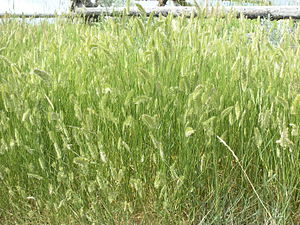Comb Mercury
| Comb Mercury | ||||||||||||
|---|---|---|---|---|---|---|---|---|---|---|---|---|

Comb Mercury ( Agropyron cristatum ) |
||||||||||||
| Systematics | ||||||||||||
|
||||||||||||
| Scientific name | ||||||||||||
| Agropyron cristatum | ||||||||||||
| ( L. ) Gaertn. |
The Agropyron cristatum ( Agropyron cristatum ) is a plant from the genus of the comb couch grass ( Agropyron ) in the family of grasses (Poaceae).
description
Appearance and leaf
The comb queck is a perennial herbaceous plant and reaches heights of 20 to 60, sometimes up to 80 centimeters. The stalks are bald or sparsely hairy.
The leaf sheaths are bare. The rolled up or flat leaf blades are 5 to 15, sometimes up to 20 inches long and 0.2 to 0.9 inches wide. They are bald on top, but slightly downy hairy near the axis.
Generative characteristics
The very dense eared inflorescence is elongated-oval with a length of 2 to 6 centimeters and a width of 0.8 to 2.5 centimeters. The ear branches are very short with a length of 1 millimeter. The spikelets spread wide at a large angle from the main axis are arranged in two parts in a comb shape. The 6 to 18 millimeter wide spike axis bears three to eleven flowers . The one-nerved glumes are lanceolate or oblong-elliptical, hairy or glabrous, rarely spiky hairy. You are burned. The awn is about as long as the glume. The upper glume is about 2 to 3 millimeters and the lower about 3 to 4 millimeters long. The lemmas are hairy or glabrous, rarely spiky hairy. They are double-pointed at the tip and ciliate on the keels. The awn of the lemma reaches 2 to 4 millimeters in length. The dust bag (anthers) are approximately 4 millimeters long.
The flowering and fruiting time is between June and September.
The number of chromosomes is 2n = 28.
Occurrence
The crested mercury is widespread in the temperate zones of Asia , North Africa and large parts of Europe , but here it is preferred in the western and eastern Mediterranean and reaching as far as Central Europe. She is a neophyte in North America .
It grows preferentially on dry mountain slopes, in dry meadows and in steppes .
Systematics
It was first described in 1753 under the name ( Basionym ) Bromus cristatus in Sp. Pl .: 78 (1753) by Carl von Linné . The new combination to Agropyron cristatum (L.) J.Gaertn. was founded in 1770 by Joseph Gärtner in Novi Comment. Acad. Sci. Imp. Petrop. 14 (1): 540 (1770) published. A synonym for Agropyron cristatum (L.) J.Gaertn. is Triticum cristatum (L.) Schreb.
The following subspecies can be distinguished:
- Agropyron cristatum subsp. brandzae (Pantu & Solacolu) Melderis : It occurs only in eastern Bulgaria and eastern Romania .
- Agropyron cristatum (L.) J. Gaertn. subsp. cristatum : It occurs in European and Asian Russia, in Central Asia, in China and in Mongolia.
- Agropyron cristatum subsp. pectinatum (M.Bieb.) Tzvelev ( Agropyron pectiniforme J.J.Roem. & JASchult. ): It occurs in Europe, Asia and Morocco.
- Agropyron cristatum subsp. sabulosum Lavrenko : It occurs in Ukraine and European Russia.
- Agropyron cristatum subsp. sclerophyllum Novopokr. : It occurs only in Georgia and the Crimea .
- Agropyron cristatum subsp. tarbagataicum (Plotn.) Tzvelev : It occurs in Kazakhstan and Siberia.
swell
- Henning Haeupler, Thomas Muer: picture atlas of the fern and flowering plants of Germany . Published by the Federal Agency for Nature Conservation (= The fern and flowering plants of Germany . Volume 2 ). 2nd corrected and enlarged edition. Eugen Ulmer, Stuttgart (Hohenheim) 2007, ISBN 978-3-8001-4990-2 .
Individual evidence
- ^ Wu Zheng-yi, Peter H. Raven, Deyuan Hong (Eds.): Flora of China . Volume 22: Poaceae . Science Press / Missouri Botanical Garden Press, Beijing / St. Louis 2006, ISBN 1-930723-50-4 , pp. 439 (English). , (same text online at efloras.org).
- ↑ Rafaël Govaerts (ed.): Agropyron cristatum. In: World Checklist of Selected Plant Families (WCSP) - The Board of Trustees of the Royal Botanic Gardens, Kew . Retrieved November 14, 2016.
- ↑ a b c d e f g Agropyron cristatum in the Germplasm Resources Information Network (GRIN), USDA , ARS , National Genetic Resources Program. National Germplasm Resources Laboratory, Beltsville, Maryland. Accessed January 30, 2020.
Web links
- Agropyron cristatum (L.) J. Gaertn., Ordinary Kammquecke. In: FloraWeb.de.
- Profile and distribution map for Bavaria . In: Botanical Information Hub of Bavaria .
- Agropyron cristatum (L.) Gaertn. s. l. In: Info Flora , the national data and information center for Swiss flora . Retrieved September 27, 2015.





